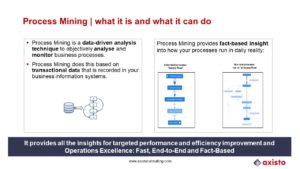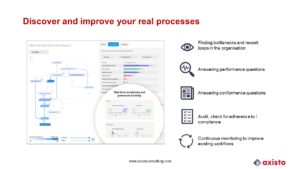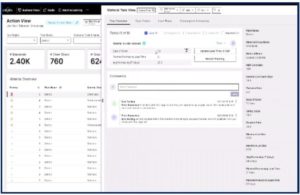Compliance deadlines vary:
Large public interest companies must report from January 1, 2024. Other large companies start on January 1, 2025. Listed SMEs must report from January 1, 2026, with an opt-out option until 2028.
The CSRD requires detailed ESG reporting aligned with the European Sustainability Reporting Standards (ESRS) and audits. Companies need to set up internal processes to gather and verify sustainability data and ensure interdepartmental collaboration. However, ESG reporting is often a complex and time-consuming process, making it an ideal candidate for automation. Hi Automation offers an effective solution with UiPath RPA (Robotic Process Automation) and RaccoonDoc IDP (Intelligent Document Processing) to streamline and improve ESG reporting. By automating ESG reporting, companies can save up to 70% of the time usually spent on data collection and processing, allowing teams to focus on more strategic and valuable activities.
HOW A DUTCH MANUFACTURING COMPANY TACKLED THIS CHALLENGE
Let’s look at the story of one of our clients, a large manufacturing company based in the Netherlands, and how they transformed their ESG reporting process using Hi Automation’s RPA and IDP solutions.
The Challenge: A Patchwork of Data Sources for the ESG Report
Our client, a renowned manufacturing company, struggled with the growing demands of ESG reporting. The necessary data for these reports was spread across different departments, from finance to procurement and supply chain. Consolidating all this information was time-consuming and error-prone, with manual data entry having a 10% error margin. The ever-changing regulations, such as compliance with the EU Taxonomy and the CSRD, added extra complexity to their processes.
The company’s ESG team spent over 500 hours annually gathering data and reporting—time that could have been better spent on strategic sustainability initiatives. Additionally, the team was under significant pressure to ensure data accuracy and meet strict deadlines. It became clear that a new approach was needed, one that would automate and simplify the ESG reporting process.
The Solution: Automation with RPA and IDP
Realizing that automation was the only way forward, the company turned to Hi Automation. We started with a thorough evaluation of their ESG reporting processes to identify key bottlenecks. Our team proposed a tailored solution, utilizing UiPath’s RPA capabilities combined with RaccoonDoc Intelligent Document Processing.
The implementation began by automating the data collection process. Using RPA, we created bots that could collect data from multiple systems and departments, automatically consolidating it into a data center. This reduced the time spent on data collection by 80%. With IDP, we addressed unstructured data sources, such as invoices and supply chain documents, extracting the necessary information with over 90% accuracy. The automation also included built-in validation checks to ensure data consistency and reliability.
The Result: Efficiency, Accuracy, and Compliance
The transformation was impressive. The time required for ESG reporting was reduced by 65%, allowing the ESG team to focus on strategic projects instead of routine data tasks. The automated data collection and processing improved the accuracy of their reports to 98%, significantly reducing the risk of compliance issues. With audit-ready reports at their fingertips, the company felt confident they could meet regulatory requirements without last-minute stress.
In addition to time savings, the financial impact was substantial. The company reported a 40% cost reduction in ESG data management. The transparency and real-time monitoring of automation also boosted stakeholder confidence, enhancing the company’s reputation with investors and partners. By automating ESG reporting, the company not only met regulatory requirements but also positioned itself as a sustainability leader in their industry.
WHY HI AUTOMATION’S APPROACH IS UNIQUE
This project demonstrates why Hi Automation’s approach to ESG reporting is the best choice for companies looking to streamline their processes and enhance their sustainability efforts.
Scalability and Flexibility:
The RPA and IDP solution is designed to be flexible and scalable, allowing the company to quickly adapt to changes in ESG regulations. This flexibility ensures they can meet new requirements without redesigning their processes.
Customizable Workflows:
We tailored the automated workflows to the company’s specific needs. This meant seamless integration with their existing systems and ensuring the solution was suited to their unique complexity.
User-Friendly Implementation:
A key advantage of our approach is its accessibility. Employees without technical expertise were able to adapt to the new tools within two weeks, ensuring a quick return on investment.
THE BROADER PERSPECTIVE: BENEFITS OF ESG AUTOMATION
The benefits of automating ESG reporting go far beyond just saving time and costs. For our client, this meant:
Improved Data Quality:
Automation virtually eliminated human errors, ensuring ESG reports were reliable and met stakeholder expectations, leading to a 98% improvement in data accuracy.
Lower Costs and Time Savings: By minimizing manual work, the company saw a 50% reduction in costs and a 60% time savings in reporting. This efficiency freed up resources that could be reinvested in other strategic initiatives.
Enhanced Compliance and Transparency:
Automation provided real-time monitoring and immediate reporting, keeping the company compliant with both local and international ESG regulations. Transparency also fostered greater trust among stakeholders, including regulators and investors.
Sustainable Growth:
The time and cost savings generated by automation are now being invested in sustainability and growth. Their improved ESG performance attracted positive investor attention and strengthened their brand reputation as a leader in sustainability.
GETTING STARTED WITH ESG AUTOMATION
The success of this project shows that automating ESG reporting is not only possible but a strategic necessity for companies looking to stay ahead in a competitive and increasingly regulated environment. Companies wishing to embark on this journey can take the following steps:
Assessment:
Identify the key ESG reporting processes that can benefit from automation, focusing on areas where manual work is the most time-consuming. Our team at Hi Automation can conduct a free assessment to identify these opportunities.
Implementation:
Take a phased approach to implementing RPA and IDP, with minimal disruption to current operations and maximum impact from automation.
We ensure smooth implementation, with over 90% of our projects completed on time.
Continuous Improvement:
Leverage automation to continuously improve ESG data collection and reporting. Our solution includes AI-based analytics to monitor and optimize ESG performance, helping you stay ahead of regulatory changes and industry standards.
CONCLUSION
Automating ESG reporting with UiPath RPA and RaccoonDoc IDP provides significant value to Dutch companies, enabling them to combine growth with sustainability. Hi Automation’s expertise ensures ESG reporting processes are efficient, accurate, and compliant, allowing companies to focus on their core business while maintaining high sustainability standards. With time and cost savings of up to 70%, automation is the best way to tackle ESG challenges effectively. Contact Hi Automation today to discover how automation can help you meet your ESG goals.



 Instead of working with the designed process flow or the process flow that is depicted in the ERP system, process mining monitors the actual process at whatever granularity you want: end-2-end process, procure-2-pay, manufacturing, inventory management, accounts payable, for a specific type of product, supplier, customer, individual order, individual SKU. Process mining monitors compliance, conformance, cooperation between departments or between client, own departments and suppliers, etc.
Instead of working with the designed process flow or the process flow that is depicted in the ERP system, process mining monitors the actual process at whatever granularity you want: end-2-end process, procure-2-pay, manufacturing, inventory management, accounts payable, for a specific type of product, supplier, customer, individual order, individual SKU. Process mining monitors compliance, conformance, cooperation between departments or between client, own departments and suppliers, etc.

